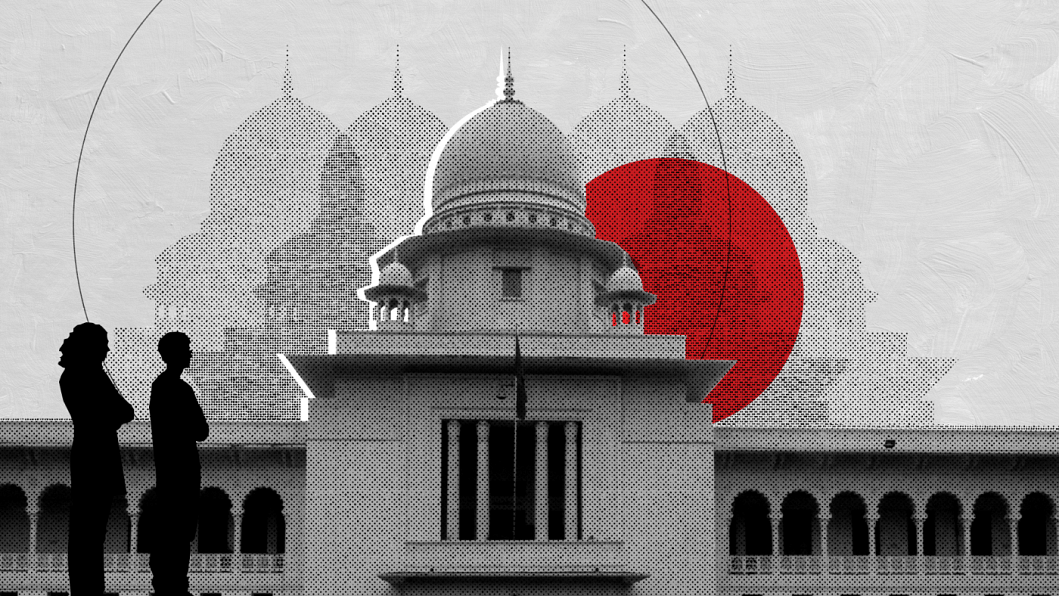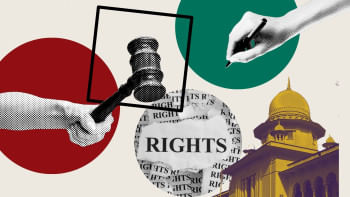Does the Eighth Amendment judgment prevent HC decentralisation?

There is very strong public support for decentralising the High Court Division of the Supreme Court. As part of its work, the Constitution Reform Commission (CRC), through the Bangladesh Bureau of Statistics, conducted a nationwide public opinion survey on constitutional reform, gathering responses through direct interviews with nearly 46,000 citizens. The results show that over 88 percent of the respondents support the establishment of a High Court in each administrative division (CRC Report, Part 2).
Recommendations of the CRC and the JRC
In view of public opinion, it is not surprising that both the CRC and the Judiciary Reform Commission (JRC) recommended decentralisation of the High Court, though their recommendations varied slightly. The CRC proposed establishing permanent seats of the High Court in all divisions, while the JRC recommended setting up permanent benches in each division. Both commissions also provided justifications for their recommendations.
Implementation of either of the recommendations—permanent seats or permanent benches—would require an amendment to Article 100 of the constitution. Article 100 provides as follows: "The permanent seat of the Supreme Court shall be in the capital, but sessions of the High Court Division may be held at such other place or places as the Chief Justice may, with the approval of the President, from time to time appoint."
Thus, under the existing constitutional provisions, only "sessions" of the High Court can be held outside Dhaka; neither permanent seats nor permanent benches can be established outside the capital.
Both reform commissions considered the existing provision regarding "sessions" in Article 100 inadequate for the decentralisation of the High Court for various reasons. Firstly, this provision has failed to result in any decentralisation over the past 50 years. Secondly, and more importantly, it lacks the capacity to ensure effective decentralisation. Thirdly, sessions held at the discretion of the chief justice, which are neither constitutionally mandatory nor permanent, cannot effectively facilitate the dispensation of judicial functions outside the capital. As a result, both commissions favoured a permanently decentralised High Court, either through permanent seats or permanent benches.
The Eighth Amendment Case
There were earlier attempts to permanently decentralise the High Court. Between 1982 and 1986, several permanent benches (initially four, and later three more) were established outside the capital through martial law proclamations. In 1988, Article 100 was amended by the Eighth Amendment to the constitution, creating six permanent benches in Barishal, Chattogram, Cumilla, Jashore, Rangpur, and Sylhet.
The constitutionality of the Eighth Amendment—specifically, its provisions regarding the decentralisation of the High Court—was challenged in the famous Eighth Amendment Case. In a groundbreaking judgment delivered on September 2, 1989, the Appellate Division of the Supreme Court of Bangladesh declared the amended Article 100, which established six permanent High Court benches outside Dhaka, to be unconstitutional.
The Eighth Amendment Case is remarkable for various reasons. In this case, the Bangladesh Supreme Court adopted and applied the constitutional law doctrine of basic structure for the first time. According to this doctrine, the constitution contains certain fundamental features that cannot be altered or destroyed through amendments. This case was argued by counsel and decided by judges who remain among the most distinguished in the history of the Supreme Court.
The case was pursued by the bar and decided by the court in the face of a military dictator whose sole purpose in decentralising the High Court was to weaken both the bar and the bench. The Eighth Amendment judgment marked a turning point in both the constitutional and political history of the country. It consolidated and catalysed a resistance that eventually led to the fall of the military regime in 1990.
Given that in the Eighth Amendment Case the Appellate Division declared the creation of permanent benches of the High Court unconstitutional, the question that arises is whether this case poses a bar to implementing the recommendations of the CRC or the JRC. This question can be approached in three ways, and in each case, the answer is an emphatic "no."
The first approach is to identify the reasons why the Eighth Amendment was declared unconstitutional and to avoid those features in any future amendment. The second approach, which may be more compelling, is to rely on the constitutional rules of interpretation that allow a departure from earlier interpretations in subsequent cases. The third approach is to have recourse to the constituent power to adopt the necessary constitutional amendment for the decentralisation of the High Court.
Avoiding the flaws of the Eighth Amendment
In the Eighth Amendment Case, the Appellate Division held that the amendment stripped the High Court of the plenary judicial power of the Republic vested in it, thereby seriously undermining—if not altogether destroying—a basic structural pillar of the constitution: the judiciary. By creating seven separate courts with exclusive territorial jurisdiction, the amendment fragmented the "oneness" of the High Court.
A future amendment to Article 100 could remedy these flaws by granting all permanent seats plenary jurisdiction, free from territorial limitations. The allocation of cases among these seats could then be managed through regulations framed by the Supreme Court itself. While all seats would retain full jurisdiction, the distribution of matters could be guided by considerations such as the location of the parties, the subject matter of the dispute or the origin of the cause of action, and the nature of the dispute. Additionally, individual seats could be granted discretionary authority to transfer cases if another seat is better suited to hear them. The chief justice could also have the discretion to transfer cases from one seat to another. With proper regulations, effective management, and technological support, it is entirely feasible to ensure an efficient and orderly distribution of cases among the permanent seats across the eight divisions.
These are not issues that would need to be addressed for the first time. Judicial systems around the world routinely deal with questions of territorial and subject-matter jurisdiction. While our High Court is currently free from such constraints, decentralisation will inevitably give rise to these issues. However, as with any other court, they can be effectively managed through appropriate procedures and regulations.
Departing from the Eighth Amendment Case
Even if a future change to Article 100 is designed to avoid legal issues related to plenary or territorial jurisdiction of the High Court, it might still face challenges for violating the broader finding of the Eighth Amendment Case, namely, that having multiple seats or benches of the High Court is unconstitutional. Therefore, the second approach mentioned above—departing from earlier interpretations in subsequent cases—is both more crucial and more compelling.
The rules for interpreting a constitution are markedly different from those applicable to other written instruments, including ordinary legislation. The conventional fetters of legal interpretation do not apply to a constitution, allowing the court greater flexibility to depart from its earlier interpretations.
A constitution is designed to endure, but its continued relevance depends on its ability to adapt to the evolving needs of society. It must be interpreted in light of the changing conditions and challenges of each era. A rigid approach cannot adequately address new developments. Therefore, the constitution should be seen as a living instrument—one that grows, adapts, and remains responsive to political, economic, and social change. Each generation has the right to shape the legal order under which it lives, and no constitutional provision, including Article 100, can remain unamendable forever. Since the framers could not anticipate every future circumstance, constitutional interpretation must provide not only stability but also ensure the flexibility to evolve. These principles are well recognised in constitutional jurisprudence across many countries, including Bangladesh (S Bhuiyan, Revolutionary Constitutionalism (UPL, 2025), pp 14-20).
The decisions of the US Supreme Court on segregation and abortion are well-known examples of departures from earlier interpretations in subsequent cases. In Plessy v Ferguson (1896), the Court upheld racial segregation, a decision that was later overturned in Brown v Board of Education (1954), when it unanimously ruled that racial segregation in public schools was unconstitutional. Similarly, in Roe v Wade (1973), the Court recognised a constitutional right to abortion. However, in Dobbs v Jackson Women's Health Organization (2022), the court overturned Roe, ruling that the constitution does not confer a right to abortion.
Since 1989, when the Eighth Amendment Case was decided, Bangladesh has undergone significant transformations in its demographics, economic activities, litigation patterns, and most notably, the volume of legal disputes and cases. These changes are critical to consider when assessing the constitutionality of any new attempts to decentralise the High Court.
Between 1989 and today, the population has grown from approximately 100 million to over 170 million. During the same period, the country's GDP has increased from $28 billion (roughly $7.5 billion at the current exchange rate) to $415 billion. The number of pending court cases has surged from a few hundred thousand to more than 4.5 million. These substantial shifts make it imperative to reconsider the 1989 decision in the Eighth Amendment Case, as the context has drastically evolved.
Moreover, treating a specific constitutional interpretation as eternally binding results in what could be described as a form of "necrocracy"—a situation where decisions made by past authorities disproportionately shape the present. While the majority of judges who ruled the decentralisation of the High Court unconstitutional in 1989 may have made the best decision given the context of their time, allowing that ruling to indefinitely bind future generations can have serious adverse effects on public governance.
Having recourse to constituent power
Another available safeguard against a future decentralisation of the High Court being declared unconstitutional by the Supreme Court lies in invoking constituent power to enact the necessary constitutional amendment.
The basic structure doctrine is grounded in the idea that legislative power under the constitution is limited. Legislative power is derivative—it is granted by the constitution and must operate within its framework. In contrast, constituent power refers to the authority to create or fundamentally alter a constitution. This power resides with the people themselves.
Under Article 142 of our constitution, parliament holds the power to amend the constitution. However, this is a derivative power and therefore subordinate to the constitution. As such, it cannot be used to alter the basic structure, which constitutes the inviolable core of the constitution.
A decentralisation of the High Court, enacted through a constitutional amendment approved directly by the people in a referendum, would constitute an exercise of constituent power. As this power exists outside the limits of the basic structure doctrine, such an amendment would not be subject to invalidation by the Supreme Court on the ground of unconstitutionality.
Dr Sharif Bhuiyan, senior advocate at the Supreme Court of Bangladesh, served as a member of the Constitution Reform Commission. His latest book is Revolutionary Constitutionalism (UPL, 2025).
Views expressed in this article are the author's own.
Follow The Daily Star Opinion on Facebook for the latest opinions, commentaries and analyses by experts and professionals. To contribute your article or letter to The Daily Star Opinion, see our guidelines for submission.


 For all latest news, follow The Daily Star's Google News channel.
For all latest news, follow The Daily Star's Google News channel. 





Comments